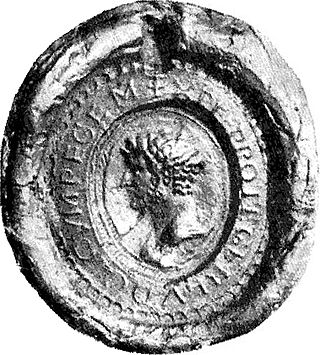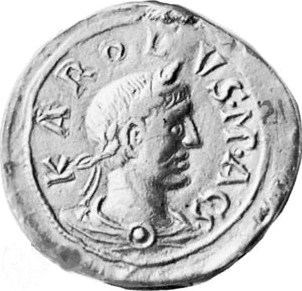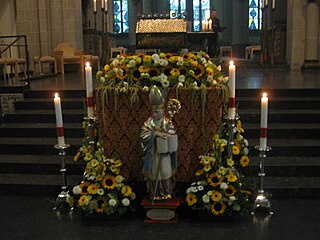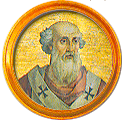Related Research Articles

The First Council of the Lateran was the 9th ecumenical council recognized by the Catholic Church. It was convoked by Pope Callixtus II in December 1122, immediately after the Concordat of Worms. The council sought to bring an end to the practice of the conferring of ecclesiastical benefices by people who were laymen, free the election of bishops and abbots from secular influence, clarify the separation of spiritual and temporal affairs, re-establish the principle that spiritual authority resides solely in the Church and abolish the claim of the Holy Roman Emperor to influence papal elections.

Louis the German, also known as Louis II of Germany and Louis II of East Francia, was the first king of East Francia, and ruled from 843 to 876 AD. Grandson of emperor Charlemagne and the third son of Louis the Pious, emperor of Francia, and his first wife, Ermengarde of Hesbaye, he received the appellation Germanicus shortly after his death when East Francia became known as the kingdom of Germany.
Pope Nicholas I, called Nicholas the Great, was the bishop of Rome and ruler of the Papal States from 24 April 858 until his death. He is remembered as a consolidator of papal authority, exerting decisive influence on the historical development of the papacy and its position among the Christian nations of Western Europe. Nicholas I asserted that the pope should have suzerainty over all Christians, even royalty, in matters of faith and morals.

Charles III, also known as Charles the Fat, was the emperor of the Carolingian Empire from 881 to 888. A member of the Carolingian dynasty, Charles was the youngest son of Louis the German and Hemma, and a great-grandson of Charlemagne. He was the last Carolingian emperor of legitimate birth and the last to rule a united kingdom of the Franks.

Hincmar, archbishop of Reims, was a Frankish jurist and theologian, as well as the friend, advisor and propagandist of Charles the Bald. He belonged to a noble family of northern Francia.

Gottschalk of Orbais was a Saxon theologian, monk and poet. Gottschalk was an early advocate for the doctrine of two-fold predestination, an issue that ripped through both Italy and Francia from 848 into the 850's and 860's. Led by his own interpretation of Augustine's teachings on the matter, he claimed the sinfulness of human nature and the need to turn to God with a humility for salvation. He saw himself as a divine vessel calling all of Christianity to repent for decades of Civil War. His attempts of this new Christianisation of Francia ultimately failed, his doctrine was condemned as heresy at the 848 council of Mainz and 849 council of Quierzy. Following his conviction as a heretic Gottschalk remained stubborn to his ideology disobeying the ecclesiastical hierarchy, making him an "actual heretic in the flesh", for this disobedience Gottschalk was placed in monastic confinement; however the shockwaves his ideology sent around Western Christendom refused to stop reverberating, Gottschalk managed to win over more followers and the threat remained up until his death in 868.
The Quinisext Council, i.e. the Fifth-Sixth Council, often called the Council in Trullo, Trullan Council, or the Penthekte Synod, was a church council held in 692 at Constantinople under Justinian II. It is known as the "Council in Trullo" because, like the Sixth Ecumenical Council, it was held in a domed hall in the Imperial Palace. Both the Fifth and the Sixth Ecumenical Councils had omitted to draw up disciplinary canons, and as this council was intended to complete both in this respect, it took the name of Quinisext. It was attended by 215 bishops, mostly from the Eastern Roman Empire. Basil of Gortyna in Crete belonged to the Roman patriarchate and called himself papal legate, though no evidence is extant of his right to use that title.
Pseudo-Isidore is the conventional name for the unknown Carolingian-era author behind an extensive corpus of influential forgeries. Pseudo-Isidore's main object was to provide accused bishops with an array of legal protections amounting to de facto immunity from trial and conviction; to secure episcopal autonomy within the diocese; and to defend the integrity of church property. The forgeries accomplished this goal, in part, by aiming to expand the legal jurisdiction of the Bishop of Rome.
Arles in the south of Roman Gaul hosted several councils or synods referred to as Concilium Arelatense in the history of the early Christian church.
Collections of ancient canons contain collected bodies of canon law that originated in various documents, such as papal and synodal decisions, and that can be designated by the generic term of canons.
Liutbert was the Archbishop of Mainz from 863 until his death. He also became Abbot of Ellwangen in 874 and is reckoned the first Archchancellor of Germany. He was one of the major organisers—along with Henry of Franconia—of the vigorous and successful defence of East Francia against Viking attack during his last decade.
Wilbert was the archbishop of Cologne from 870 until his death.
Theotgaud was the archbishop of Trier from 850 until his deposition in 867. He was the abbot of Mettlach prior to his election in 847 to succeed his uncle, Hetto, as archbishop.

Saint Altfrid was a leading figure in Germany in the ninth century. A Benedictine monk, he became Bishop of Hildesheim, and founded Essen Abbey. He was also a close royal adviser to the East Frankish King Louis the German.
Hincmar, called the Younger, was the Bishop of Laon in the West Frankish Kingdom of Charles the Bald from 858 to 871. His career is remembered by a succession of quarrels with his monarch and his uncle, archbishop Hincmar of Rheims. After initial loyalty to Charles trouble occurred from 868 due to the allocation of benefices on the see's estates. The conflict grew dangerous as it became embroiled in the larger dispute of Lotharingian succession following Lothair II’s attempted divorce from his wife. Hincmar’s struggle against his king provides a Carolingian example of early Medieval clerical exemption.

The Lateran Council of 769 was a synod held in the Basilica of St. John Lateran to rectify perceived abuses in the papal electoral process which had led to the elevation of the antipopes Constantine II and Philip. It also condemned the rulings of the Council of Hieria. It is perhaps the most important Roman council held during the 8th century.

The Archbishopric of Moravia was an ecclesiastical province, established by the Holy See to promote Christian missions among the Slavic peoples. Its first archbishop, the Byzantine Methodius, persuaded Pope John VIII to sanction the use of Old Church Slavonic in liturgy. Methodius had been consecrated archbishop of Pannonia by Pope Adrian II at the request of Koceľ, the Slavic ruler of Pannonia in East Francia in 870.
Ermanrich or Ermenrich was a Benedictine monk and court chaplain, who became Bishop of Passau from 866 to 874. He supported East Francia's expansion to the east, and likewise the expansion of the eastern bishoprics, and opposed the missionary efforts of Cyril and Methodius, who he considered intruders. This brought him into conflict with the Papacy, which supported the brother missionaries.
The Council of Constantinople was a conference of the endemic synod held in Constantinople, the capital of the Eastern Roman Empire, in May–June 536. It confirmed the deposition of the Patriarch Anthimus I of Constantinople and condemned three prominent anti-Chalcedonians living in Constantinople, causing the Emperor Justinian I to ban all four from the capital. The Council of Jerusalem held in September was convoked to condemn the same four as heretics. The condemned were the deposed Patriarch Severus of Antioch, the deposed Bishop Peter of Apamea and the monk Zoora.

The Council of Würzburg, also called the Synod of Würzburg or Diet of Würzburg, was a simultaneous church council and royal diet held in Würzburg in March 1287.
References
- 1 2 Eric J. Goldberg, Struggle for Empire: Kingship and Conflict Under Louis the German, 817–876 (Cornell University Press, 2006), pp. 282–283.
- 1 2 Robert Somerville, "Review of Hartmann, Das Konzil von Worms 868", Speculum55:3 (1980), pp. 578–580. JSTOR 2847261
- ↑ The acta are found at pp. 246–311 in MGH, Concilia 4, Die Konzilien der karolingischen Teilreiche 860–874, ed. Wilfried Hartmann.